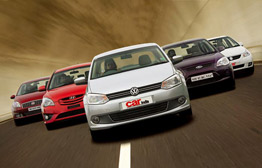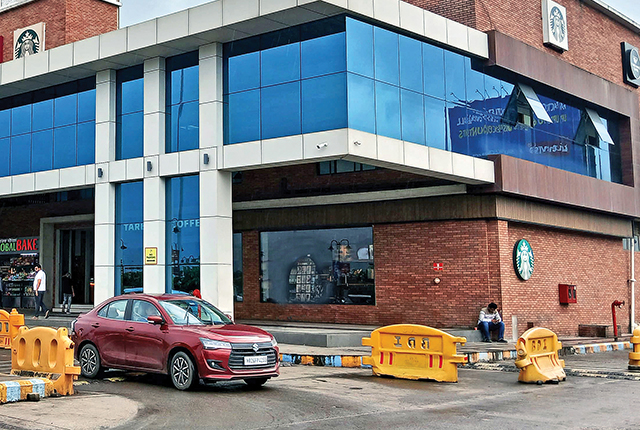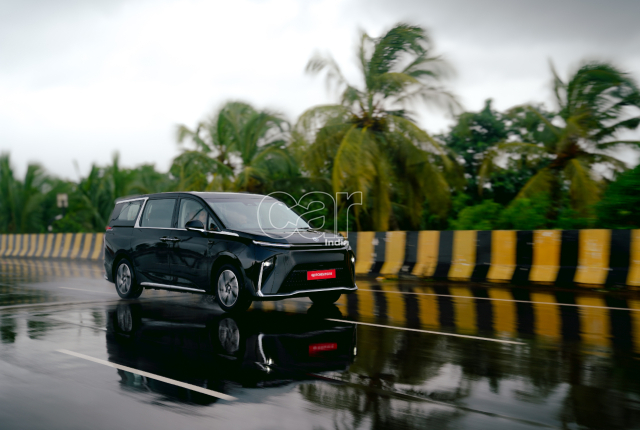Interior and comfort
You need to slouch a bit to enter the Verna; ingress and egress aren’t as easy as in any of the other four cars under consideration here. The confusing and overly-detailed interior mirrors that of the body styling, with a surfeit of organic and geometric themes that tend to clash. The materials used are  good; in fact, better than those in the Fiesta or the SX4, but the finish is nowhere close to the Vento’s.
good; in fact, better than those in the Fiesta or the SX4, but the finish is nowhere close to the Vento’s.
The rear seats are low, too and while the seat squab itself provides for decent under-thigh support, the room in the back isn’t particularly generous.
Performance and fuel-efficiency
The Verna is the least fuel-efficient of this bunch and that does not do it any favours. The acceleration and top speed are average too. The gearshift quality and steering aren’t too bad, but it isn’t an exciting car to drive. The controls are well-weighted, though, and the Verna’s European influence can be sensed in the driving characteristics of the car, which help it somewhat. The leather-wrapped steering wheel feels nice to hold.
Value
At Rs 8.5 lakh (OTR, Pune) the Verna is priced on par with the competition. Once again, the petrol  version isn’t the hot seller and Hyundai seem to suffer from a similar conundrum as Maruti: buyers haven’t really taken to the Verna. The Accent, which pre-dates the Verna, was a reasonably strong seller, but the Verna in its petrol guise hasn’t caught the market’s fancy.
version isn’t the hot seller and Hyundai seem to suffer from a similar conundrum as Maruti: buyers haven’t really taken to the Verna. The Accent, which pre-dates the Verna, was a reasonably strong seller, but the Verna in its petrol guise hasn’t caught the market’s fancy.
The Ford Fiesta
Design and Style
The Fiesta has been around for a few years now and is quite a common sight on our roads. For 2010, the car has a re-styled nose with a new bumper that has integrated fog lamp recesses, but the rest of the car remains unchanged. In fact, even at launch there was nothing ‘new’ or exciting about the Fiesta. The tail-lights are bland looking items and the generic three-box look in profile is nothing exciting.
 Interior and comfort
Interior and comfort
The Fiesta’s interior has aged gracefully and, even in 2010, the design seems acceptable with the pod-like a-c vents and the big D-shaped steering wheel boss. The notched chrome surrounds of the instrument dials is a detail that I quite like. The Fiesta’s seats feel more snug and hold you well, but the padding is softer and you begin to fidget in your seat after a while. Slightly firmer padding would be a good idea. The rear seat is easy to get in and out of, but it isn’t particularly roomy, relying instead on a well-packaged rear cabin with optimum space utilisation.
 Performance and fuel-efficiency
Performance and fuel-efficiency
The Fiesta feels faster than it actually is. That isn’t to say it’s not a quick car, it’s just that you realise, after you look at the VBOX data, that it may be a little quicker than the others, but the Vento still matches it stride for stride without ever seeming like it has. What the Fiesta does have, though, is the most enthusiastic response from the controls. It involves you more, makes a lovely sound when you accelerate and the sharp and slightly heavy steering is actually just what the doctor ordered when you’re in the mood. The brakes aren’t the best and if there is a grouse in respect of the Fiesta, it has to be the brakes. What I particularly like is the tall gear lever with its fast shifting gearbox.






















Leave a Reply